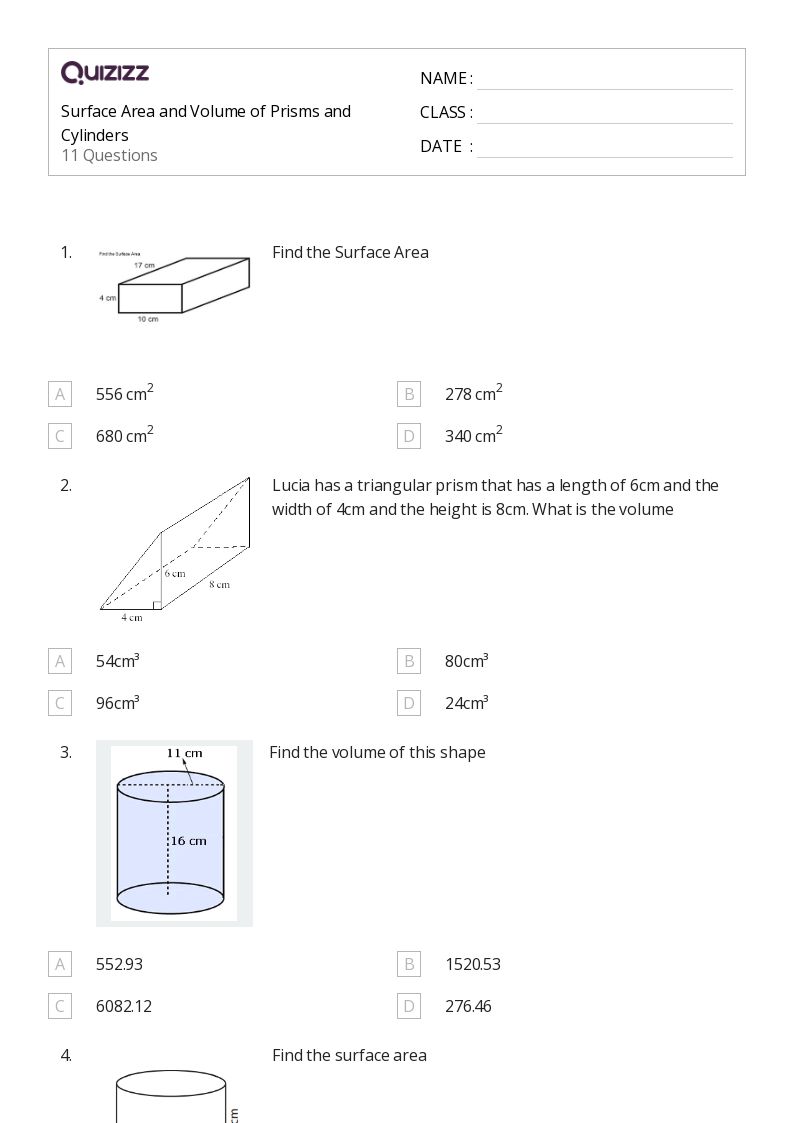The surface area of a prism is the sum of the areas of its bases and faces. Learn how to use these formulas to solve an example problem. The lateral area is the sum of the areas of the lateral faces. Which expression gives the volume of the oblique rectangular prism? Web the surface area (s) of a prism is equal to the sum of the areas of the prism’s bases and lateral faces.
Visual in the figure below: Surfacearea = b1 +b2 +l1 +l2 +l3 s u. A = 75.6 + 12.6 + 12.6 = 100.8units2 a = 75.6 + 12.6 + 12.6 = 100.8 u n i t s 2 to find the volume of a cylinder we multiply the base area (which is a circle) and the height h. The basic unit of area is the square unit. We’ll start with the volume and surface area of rectangular prisms.
A = 75.6 + 12.6 + 12.6 = 100.8units2 a = 75.6 + 12.6 + 12.6 = 100.8 u n i t s 2 to find the volume of a cylinder we multiply the base area (which is a circle) and the height h. A prism is a polyhedron with flat faces. The basic unit of area is the square unit. Find lateral area and surface area of the given prism. Surface area is measured in square units.
Therefore, the formula for the surface area of a prism and a cylinder is as follows. For example, \mathrm {mm}^2, \mathrm {~cm}^2, \mathrm {~m}^2 mm2, cm2, m2, etc. It is measured in square units like square inches, square meters, and square feet. Web test your understanding of volume and surface area with these % (num)s questions. Learn how to use these formulas to solve an example problem.
Find the surface area of the cylinder in terms of pi. We discuss unfolding the three dimension. We’ll start with the volume and surface area of rectangular prisms. Since lateral surface area (lsa) of a prism = base perimeter x height the lateral surface area is the area of all the faces except the bases.
Web To Find The Surface Area Of A Prism Or A Cylinder, Calculate The Top And Bottom Base Areas And Side Area, Respectively, And Add The Numbers.
Want to know how the find the lateral and surface areas of a cylinder? Web the surface area of a cylinder is the sum of the areas of its curved surface and bases; V = πr2 ⋅ h v = π r 2 ⋅ h Web r h volume circular cylinder = ( area circle) ⋅ ( height) = ( π ⋅ ( radius) 2) ⋅ ( height) = π r 2 h oblique prisms in oblique prisms, the bases are in parallel planes, we still calculate the volume in exactly the same way because of cavalieri's principle.
For Example, \Mathrm {Mm}^2, \Mathrm {~Cm}^2, \Mathrm {~M}^2 Mm2, Cm2, M2, Etc.
To find the surface area of a prism, find the sum of the areas of its faces. Find the surface area of the cylinder in terms of pi. Another type of prism is a triangular prism. Find the surface area of the cylinder in terms of pi.
Web Surface Area Of Cube = Lb + Lb + Lh + Lh + Bh + Bh = 2Lb + 2Hl + 2Bh = 2(Lb + Hl + Bh) Lateral Surface Area = Bh + Bh + Hl + Hl = 2Bh + 2Hl = 2H (L+B) (Area Of Side 1, 2, Front And Back) Total Surface Area = 2(Lb + Hl + Bh) (Area Of Side 1, 2, Front, Back, Top And Bottom) Cylinder
A = 2(ab + bc + ac), where a, b and c are the lengths of three sides of the cuboid. Web the surface area (s) of a prism is equal to the sum of the areas of the prism’s bases and lateral faces. Web surface area of a cylinder: Web learn how to find the surface area of prisms and cylinder in this free math video tutorial by mario's math tutoring.
You'll See How To Apply Each Formula To The Given Information To Find The Lateral Area And Surface Area.
Which expression gives the volume of the oblique rectangular prism? The surface area of a prism is the total area occupied by the faces of the prism. How do you find the lateral and surface areas of a cylinder? The basic unit of area is the square unit.
Surfacearea = b1 +b2 +l1 +l2 +l3 s u. To find the surface area of a prism, find the sum of the areas of its faces. Web use the large 19 x 6 m rectangles on the top and bottom as bases. Having trouble viewing the video? Web surface area of a cylinder:









Ads